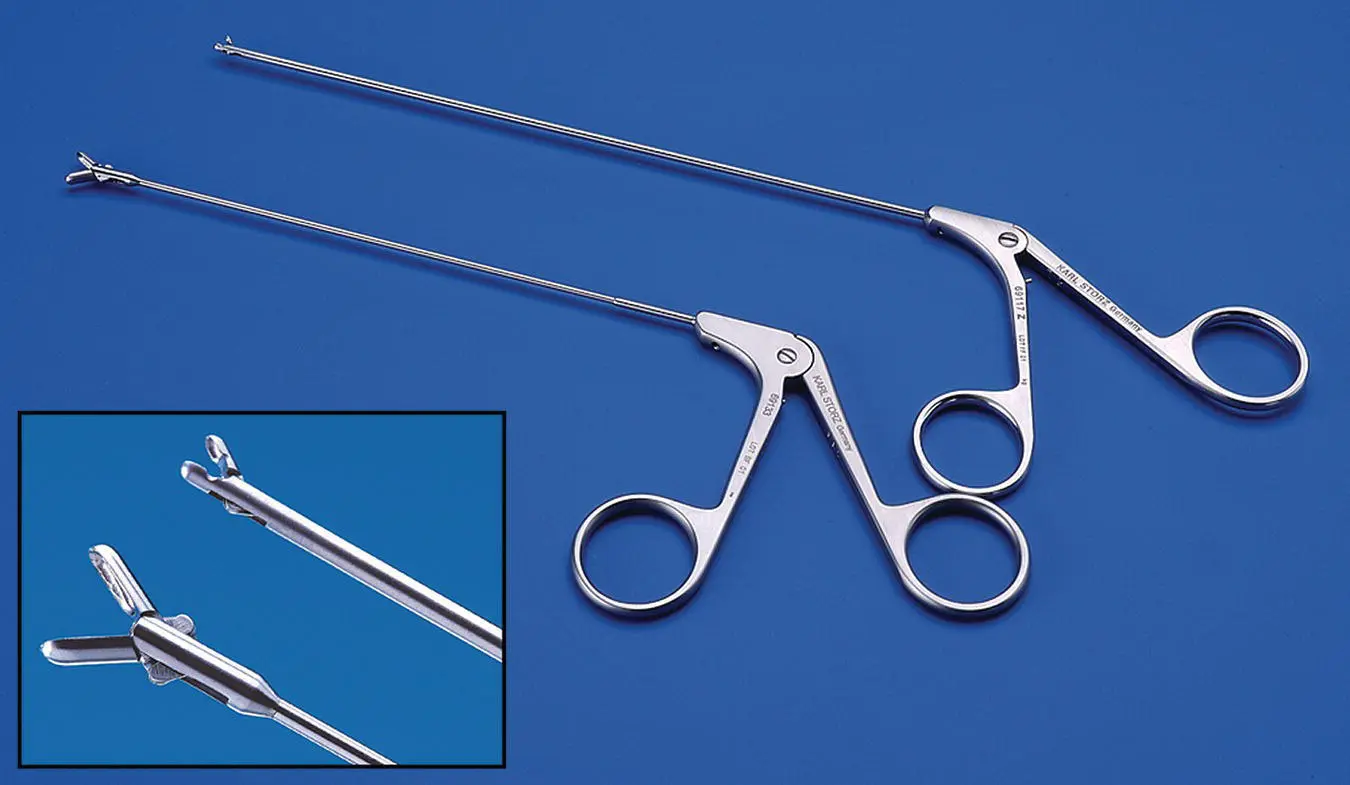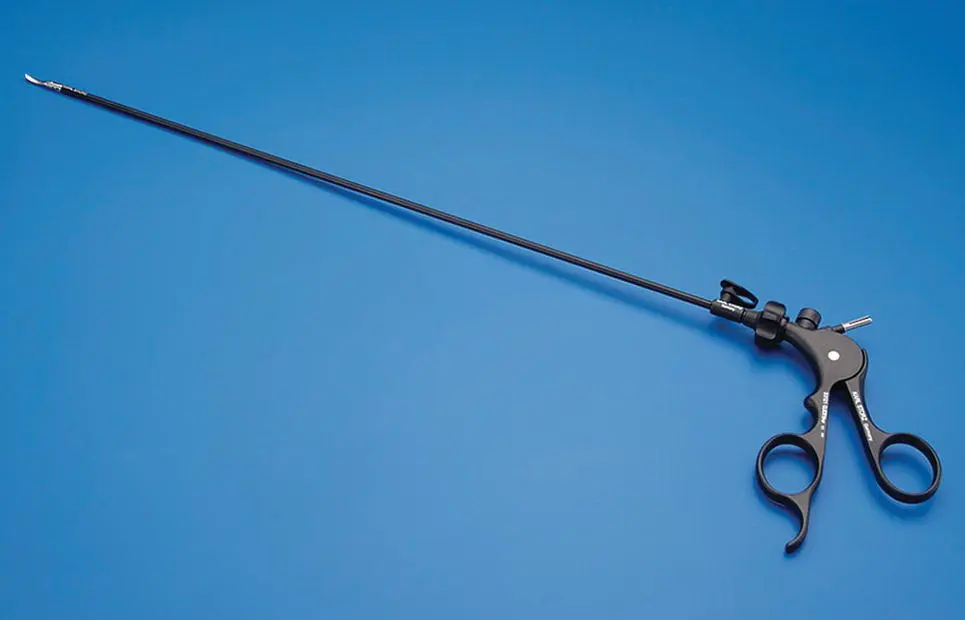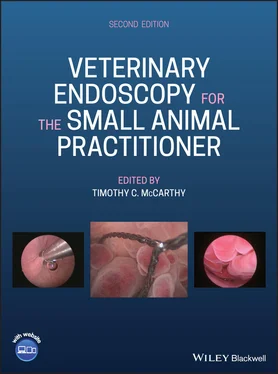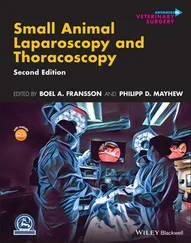Trocar‐cannulas for laparoscopy and thoracoscopy do not lock to the telescope but have a valve and gasket at their proximal end to prevent leakage of carbon dioxide during procedures ( Figure 2.38). This trocar‐cannula is smooth and is inserted by pushing the sharp trocar through the abdominal wall or using a blunt obturator to pass the cannula through a preplaced incision or to replace the canula if it is dislodged or removed for any reason. Another trocar‐cannula design is a Ternamain Endo TIP cannula that is threaded and penetrates the abdominal wall by being screwed through the tissue ( Figure 2.39). Trocar‐cannulas used for laparoscopy and thoracoscopy to establish operative portals are the same as the trocar‐cannulas used for the telescope portal. Trocar‐cannula sizes range from 2.5 mm diameter ( Figure 2.40) to 13.5 mm diameter and lengths from 5 to 15 cm. The smaller cannula‐trocars are made of lightweight material facilitating use in very small patients. Larger and longer trocar‐cannulas are made of stainless steel and similar to the 11 and 6 mm cannulas. Thoracoscopy commonly uses a semi‐open pneumothorax with trocar‐cannulas that are typically shorter than those for laparoscopy and do not have a valve or gasket allowing air to pass in and out of the cannula during ventilator excursions. Laparoscopy cannulas can be used for thoracoscopy by removing the valve assembly. If pleural insufflation is indicated for a specific thoracoscopy, then any laparoscopy cannula of appropriate diameter and length is used.
2.2.12 Diagnostic and Operative Instruments
Flexible instruments are used with flexible endoscopes for gastrointestinal endoscopy, bronchoscopy, cystoscopy, and rhinoscopy. Flexible instruments are also used with rigid telescopes when an operating or cystoscopy sheath is employed for cystoscopy, bronchoscopy, rhinoscopy, otoscopy, and for some of the “otheroscopies”. Flexible instruments are available for many applications with many lengths and diameters to match the size and length of working channels of flexible endoscopes or sheaths of rigid telescopes ( Figure 2.41). The common diameters for flexible instruments are 3, 5, and 7 Fr when referring to rigid telescope sheaths and 1.0 to 2.5 mm when discussing flexible endoscope instruments. These instruments are also presented in their respective chapters.

Figure 2.41 Flexible instruments for use with flexible endoscopes and rigid telescopes operating sheaths with a working channel. These instruments for flexible endoscopes are longer than those for rigid telescopes with selection to match the length of the endoscope and the diameter of the operating channel. Rigid telescope sheaths are much shorter as are their flexible instruments with the same selection of options for function and diameter. The longer instruments for flexible endoscopes of the correct diameter can be used with rigid endoscope sheaths but are cumbersome.
( Source: Photo courtesy of Karl Storz: ©Karl Storz SE & Co KG, Germany.)
Rigid‐hand instruments are used for laparoscopy, thoracoscopy, rhinoscopy, otoscopy, and for many of the otheroscopy techniques ( Figure 2.42). Minimally invasive surgery instruments for laparoscopy and thoracoscopy are extensive and varied with as many instrument designs and configurations as there are for open surgery ( Figure 2.43). Fortunately, very few hand instruments are needed to perform the basic diagnostic and operative procedures for the most common conditions seen in small animals. A basic set of MIS hand instruments is presented in the chapter on laparoscopy with instruments for other techniques presented in their respective chapters.

Figure 2.42 An example of rigid instruments used with rigid telescopes. The top instrument is a 1.7 mm diameter biopsy forceps with a 15 cm working length. The bottom instrument has a 3.0 mm diameter oval biopsy cup on a 1.5 mm diameter shaft with a 14 cm working length. This is my favorite rigid biopsy instrument for many applications because of the larger biopsy cup size on the thin shaft.
( Source: Photo courtesy of Karl Storz: ©Karl Storz SE & Co KG, Germany.)

Figure 2.43 An example of a rigid 5 mm diameter, 36 cm long minimally invasive surgery instrument. Multiple handle designs are available with an extensive number of instrument function options. These instruments can be dismantled into three parts for cleaning, a working insert, an insulated metal outer sheath, and the handle. The parts are interchangeable. The working insert rotates independent of handle position allowing the instrument to be aligned to the tissue without requiring awkward hand position.
( Source: Photo courtesy of Karl Storz: ©Karl Storz SE & Co KG, Germany.)
Конец ознакомительного фрагмента.
Текст предоставлен ООО «ЛитРес».
Прочитайте эту книгу целиком, купив полную легальную версию на ЛитРес.
Безопасно оплатить книгу можно банковской картой Visa, MasterCard, Maestro, со счета мобильного телефона, с платежного терминала, в салоне МТС или Связной, через PayPal, WebMoney, Яндекс.Деньги, QIWI Кошелек, бонусными картами или другим удобным Вам способом.















